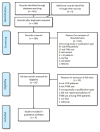Traditional herbal medicine use among hypertensive patients in sub-Saharan Africa: a systematic review
- PMID: 24764197
- PMCID: PMC4076776
- DOI: 10.1007/s11906-014-0437-9
Traditional herbal medicine use among hypertensive patients in sub-Saharan Africa: a systematic review
Abstract
Hypertension is increasingly common in sub-Saharan Africa, and rates of hypertension control are low. Use of traditional herbal medicines (THM) is common among adults in sub-Saharan Africa and may affect hypertension therapy. We searched Ovid MEDLINE, Ovid EMBASE, and Web of Knowledge in June 2013 to find studies about THM use among hypertensive patients living in sub-Saharan Africa. Two independent reviewers evaluated titles and abstracts. Qualifying references were reviewed in full text. Data were extracted using a standardized questionnaire. Four hundred and eighty-one references were retrieved, and four articles from two countries met criteria for inclusion. The prevalence of THM use was 25-65% (average 38.6%). THM was the most common type of complementary and alternative medicines used by patients (86.7-96.6%). Among THM users, 47.5% concomitantly used both allopathic medicine and THM. Increased age (p<0.001), male sex (RR 2.58), belief in a supernatural cause of hypertension (RR 2.11), and family history of hypertension (OR 1.78) were positively associated with THM use, while belief that hypertension is preventable was negatively associated with THM use (OR 0.57). More than one-third of adults with hypertension in sub-Saharan Africa use THM. Half of these patients use THM concurrently with allopathic medicine. Healthcare workers in sub-Saharan Africa must discuss THM use with their hypertensive patients. More research is urgently needed to define the impact of THM use on hypertension control and outcomes in sub-Saharan Africa.
Conflict of interest statement
Figures
References
-
- Zein ZA, Assefa M. Blood-pressure levels and hypertension in rural Ethiopian communities. Ethiop Med J. 1986;24:169–78. - PubMed
-
- Department of Cardiology Cairo University Faculty of Medicine and Qalyub Training and Demonstration Centre. Qalyub heart survey. Bull Egypt Soc Cardiol. 1958;1:99–105.
-
- Donnison C. Blood Pressure in the African Native: Its bearing upon the aetiology of hyperpiesia and arterio-sclerosis. Lancet. 1929;213:6–7.
-
- Twagirumukiza M, De Bacquer D, Kips JG, de Backer G, Stichele R Vander, Van Bortel LM. Current and projected prevalence of arterial hypertension in sub-Saharan Africa by sex, age and habitat: an estimate from population studies. J Hypertens. 2011;29:1243–52. This study is a systematic review of hypertension prevalence in sub-Saharan Africa It compares urban versus rural rates and provides both curent and projected estimates of the total number of people with hypertension in sub-Saharan Africa. - PubMed
-
- Njelekela M, Negishi H, Nara Y, Tomohiro M, Kuga S, Noguchi T, et al. Cardiovascular risk factors in Tanzania: a revisit. Acta Trop. 2001;79:231–9. - PubMed
Publication types
MeSH terms
Grants and funding
LinkOut - more resources
Full Text Sources
Other Literature Sources
Medical
Miscellaneous


